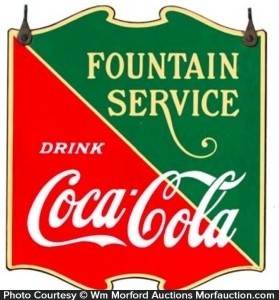Unfortunately, although most antique dealers and collectors are honest, you always have to keep an eye out for fakes, reproductions and antique restoration when buying. As time has passed, the forgeries have gotten better and better while many of our eyes of gotten worse and worse. Aside from using only REPUTABLE DEALERS AND AUCTIONEERS, your best bet is to familiarize yourself with a black light and a few basic techniques to detect any potential problems. The Ultra Violet or “UV” light that is emitted cause many substances to fluoresce and reveal areas or materials that aren’t original to the piece. These techniques work on a wide range of materials and should be your go to when purchasing antiques.
Porcelain
When purchasing a piece of porcelain, especially porcelain signs, you should ask the dealer if you could take it into a darkened area for examination. Although the sign may look right to the eye, a black light never lies. When exposed to this light, the color of the antique restoration will glow a distinctly different color than the rest of the porcelain and quickly help you detect any antique restoration or touch-up. As a general rule, the harder the porcelain paste, the darker the color under a black light with hard paste turning a deep purple/blue and softer pastes appearing almost white.

Cast Iron
In the early 1900’s many toys, banks, doorstops and household accessories were constructed using cast iron before the world wars. Unfortunately, over the years many of these pieces have been repainted and are being passed off as original. Fortunately, more modern paints glow under Ultra Violet Light while original paints maintain their looks. As the bulk of the value of many of these pieces is derived from the original paint, always be sure to inspect it before purchasing along with any other authentication techniques you have at your disposal
Glassware
Although black lights don’t work on all types of glass, it is worth noting that several techniques have surfaced which can help you age glass or even detect fakes. For example Lalique glass created before 1945 gives off a yellow hue under black light while that made after 1945 doesn’t. Burmese glassware fluoresces bright yellow/green unlike the fakes and reproduction pieces. American pressed glass from the 1920’s and earlier will glow yellow while American brilliant glass give off a light purple or blue color. Finally authentic depression and Vaseline glass both glow under Ultra Violet light.
Textiles
Most of the post world war II fabrics will glow under a red light and serve as an excellent way to date pieces or check for antique restoration. This can be useful for all textiles and fabrics although original fabrics which have been treated may fluoresce due to exposure to modern chemicals. As a general rule, if a fabric glows under a black light, proceed with caution.
Artwork
As mentioned in the cast iron section, original and modern paints respond differently depending on the age of the paint. When looking at artwork under a UV light, the same rule applies and allows you to get a feel for the age of the paint and search for any spots of restoration or treatment. Special black lights are made for examining artwork and often times pieces are restored using repurposed period paint so always remember to proceed with caution.
Ephemera
Old paper products, like most antiques have gone through many periods of modernization spanning a wide range of materials and techniques. Paper goods made after the mid 1930’s are much more likely to respond to black lights due to the modern dyes and chemicals that weren’t used in previous periods. Ephemera is a particularly tricky category and just because nothing is detected doesn’t mean the piece is original. Like all black light tests, this is a mere step in the authentication process.
When authenticating a piece, you shouldn’t rely on black light alone. Countless books have been written on various approaches to authenticate antiques and things such as manufacturer, markings, signatures and types of materials should be thoroughly researched before making any purchases unless you are working with a dealer you trust.
Tips for using a black light
-Always use the light in a dark room
-Remove the piece from any holder or container
-Shine the black light on the whole piece
-Carry modern paper with you for comparison
-Practice makes perfect
-Give your eyes a minute to adjust to the dark
-Make sure the background doesn’t glow for better comparison
What techniques do you use to authenticate antiques before your purchase?? Please share below.




I’ve seen coke Pam thermometers.that have DRINK on the top.above c..one with 495 and one with 495a. What’s the difference?